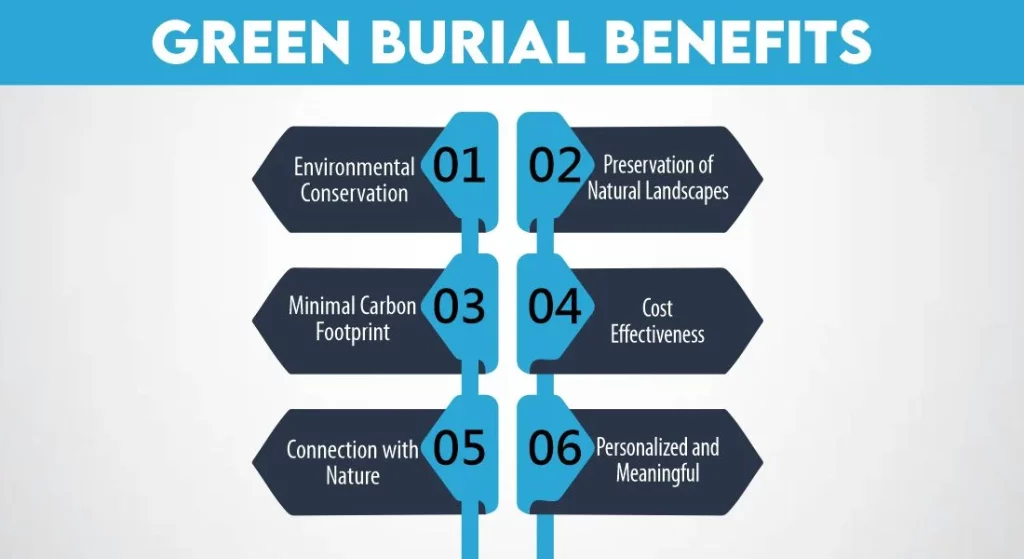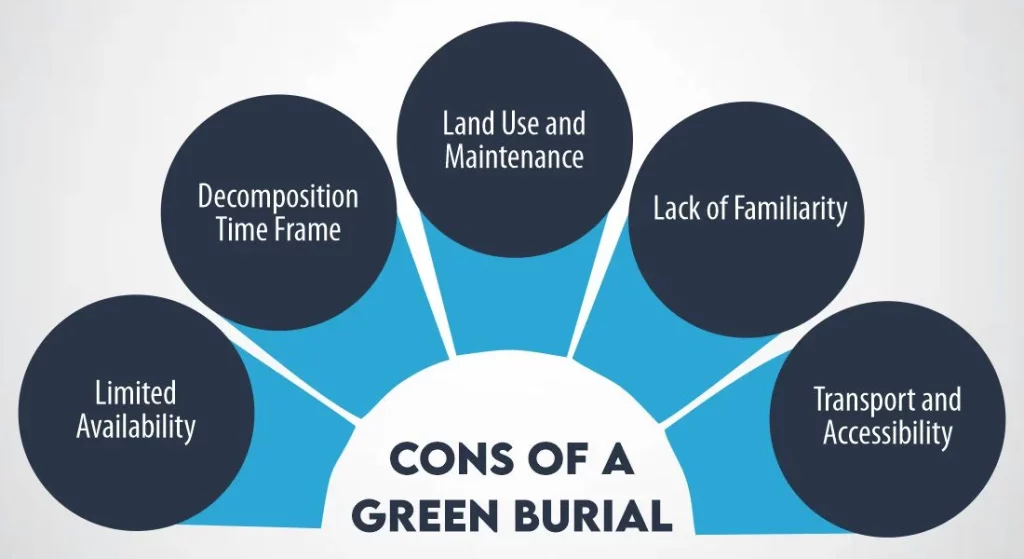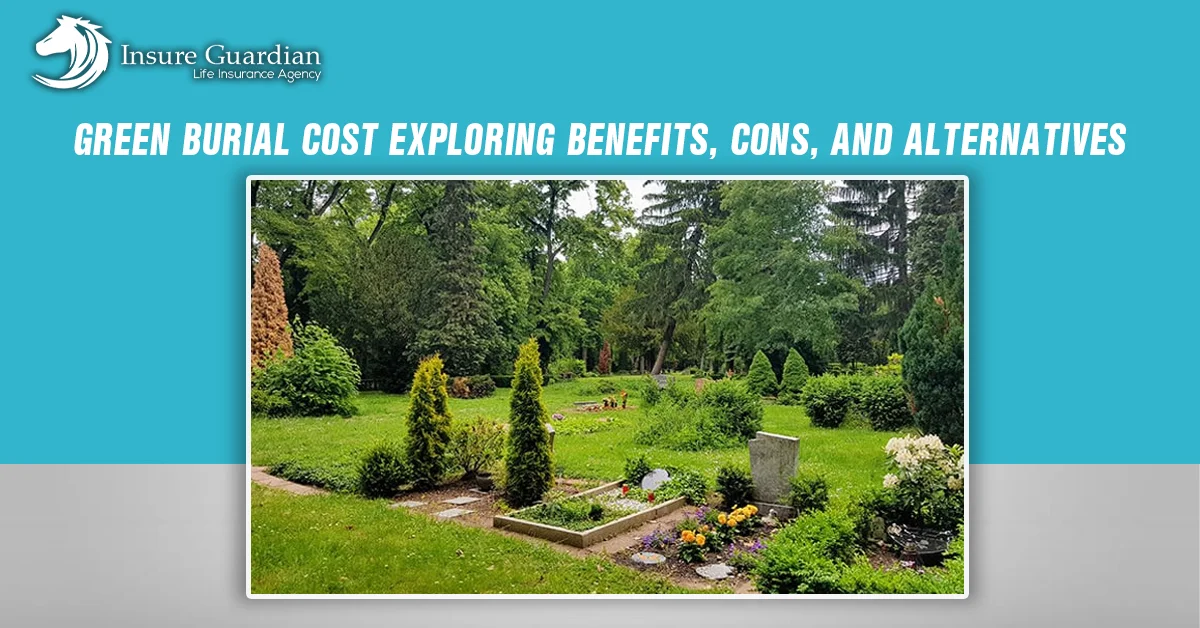Imagine a peaceful meadow, where sunlight dances through the trees and a soft breeze whispers secrets of nature. Now, imagine this serene landscape as a final resting place—a spot where dear ones bid their farewells in harmony with the world around them. That’s the essence of green burials: a departure from the traditional funeral scene, a move toward a more eco-friendly, natural goodbye.
In our world today, where being environmentally conscious is a big deal, green burials have grabbed attention. It’s not just about saying goodbye; it’s about going back to nature, honoring the circle of life, and leaving a legacy of care for the planet.
Come with us on a journey into the world of green burials; learn about their earth-friendly appeal, think about the costs, explore other options, and understand what really makes a burial ‘green’. Let’s uncover how this gentle nod to nature offers a beautiful, mindful farewell that celebrates life in its purest form.
What Is a Green Burial or Funeral?
A green burial or funeral is a departure from the conventional methods of interment, focusing on eco-friendly practices that prioritize environmental conservation and natural decomposition. Unlike traditional burials that involve embalming fluids, metal caskets, and concrete vaults, green burials aim to minimize the ecological footprint by using biodegradable materials.
In a green burial, the body is laid to rest without the use of toxic embalming fluids. Instead, biodegradable caskets, shrouds, or simple burial containers are utilized to allow the body to return naturally to the earth. This approach avoids the environmental impact associated with chemicals seeping into the soil and groundwater, promoting a more natural and sustainable way of honoring a loved one’s passing.

Green Burial Benefits
Green burials offer several notable benefits, emphasizing sustainability, environmental conservation, and a more natural approach to the end-of-life process. Here are the key advantages of opting for a green burial:
Environmental Conservation
Green burials significantly reduce the ecological impact compared to traditional burials. By avoiding embalming fluids and non-biodegradable materials like metal caskets and concrete vaults, they prevent harmful substances from entering the soil and groundwater, preserving the environment.
Preservation of Natural Landscapes
These burials often take place in dedicated natural burial grounds or conservation areas. Choosing these sites supports the preservation of natural landscapes, allowing the land to remain untouched or fostering rewilding efforts, encouraging the growth of native plants and habitats for wildlife.
Minimal Carbon Footprint
Green burials typically involve fewer carbon emissions compared to cremation or traditional burials that use energy-intensive processes or non-renewable materials. This eco-friendly approach contributes to reducing overall greenhouse gas emissions.
Cost-Effectiveness
In some cases, green burials can be more cost-effective than traditional burials due to the absence of expensive materials and elaborate procedures, offering an affordable alternative for families seeking a simpler, more budget-friendly option.
Connection with Nature
Green burials allow a more intimate connection with nature. The return of the body to the earth in a natural way can provide a sense of closure and peace, fostering a deeper understanding and acceptance of the cycle of life.
Personalized and Meaningful
Families often find green burials to be more personalized and meaningful as they align with values of environmental consciousness and sustainability, creating a lasting tribute that reflects the individual’s eco-friendly beliefs and legacy.

Cons of a Green Burial
While green burials present numerous advantages, they also come with certain considerations and limitations that individuals should take into account:
How Much Does Life Isurance Cost?
Limited Availability
Green burial sites might not be as widespread or easily accessible as traditional cemeteries in certain regions. Finding a suitable natural burialground or eco-friendly cemetery could be challenging depending on geographic location.
Decomposition Time Frame
In comparison to traditional burials that may involve embalming and sealed caskets, green burials facilitate natural decomposition. However, this natural process can take longer, potentially raising concerns about odor or land usage over extended periods in some cases.
Land Use and Maintenance
Natural burial grounds often prioritize preserving landscapes and avoiding excessive maintenance. While this preserves the environment, it might result in less manicured or structured settings, which may not appeal to everyone seeking a more traditional cemetery ambiance.
Lack of Familiarity
As green burials are a relatively newer concept, some individuals might feel uncertain or uncomfortable with the unfamiliarity of the process, making it a less preferred choice for those adhering to more conventional funeral practices.
Transport and Accessibility
In some instances, transportation logistics to reach green burial sites might pose challenges, especially for families who live far from designated eco-friendly cemeteries or natural burial grounds.
How much does a green burial cost?
Here’s a table outlining the approximate costs associated with green burials, highlighting the variations based on different factors:
| Cost Elements | Price Range |
|---|---|
| Plot in Green Burial Ground | $800 – $4,000 |
| Biodegradable Casket | $800 – $2,500 |
| Natural Burial Shroud or Urn | $100 – $500 |
| Transportation of the Body | $200 – $600 |
| Grave Opening and Closing | $500 – $1,500 |
| Ceremony and Service Fees | $300 – $1,000 |
| Additional Services (flowers, music, etc.) | $200 – $800 |
| Total Average Cost Range | $2,900 – $11,900 |
Please note that these cost ranges are approximate and can vary significantly based on factors such as geographical location, the specific green burial site, the type of casket or burial container chosen, additional services desired, and any personalized elements included in the funeral service.
It’s advisable to directly consult with green burial providers or natural burial grounds for precise pricing information and to inquire about any additional costs or packages available based on individual preferences and requirements.
Comparing Green Burial Cost vs. Cremation Cost
When considering end-of-life arrangements, comparing the costs between green burial and cremation can help individuals make informed decisions based on their preferences and budget. Here’s a breakdown of the average cost comparison between green burials and cremation:
Green Burial Cost
The total cost of a green burial typically ranges between $2,000 to $4,000 on average, varying based on location, chosen burial site, services, and the type of biodegradable materials used for the casket or shroud.
Cremation Cost
Cremation costs generally range from $1,000 to $3,000 on average, depending on factors such as location, type of service (direct cremation or with a funeral service), and additional memorial or urn options chosen.
Comparison Overview:
In terms of cost, cremation is often considered more budget-friendly than traditional burials and can sometimes be comparable or slightly less expensive than a green burial.
However, it’s essential to note that while cremation might have a lower base cost, additional services, urns, or memorial options can increase the overall expense.
Green burials offer an eco-friendly alternative at a moderate cost, aligning with environmentally conscious values and providing a natural return to the earth.
When deciding between green burial and cremation, individuals should consider their preferences, environmental concerns, budget constraints, and any additional memorialization desires to select the option that best reflects their wishes and values.
What are the alternatives to green burial?
Apart from green burials, several alternative end-of-life options cater to diverse preferences and values. Here are some notable alternatives to green burials:
- Cremation: Cremation involves the transformation of the body into ashes through high-temperature burning. It’s a popular choice due to its cost-effectiveness and versatility in memorialization. Ashes can be kept in urns, scattered in meaningful locations, or used in various memorial practices.
- Aquamation (Alkaline Hydrolysis): This eco-friendly process uses water, heat, and alkali to accelerate the body’s decomposition, resulting in bone fragments similar to cremation ashes. Aquamation is known for its lower environmental impact compared to traditional cremation.
- Burial at Sea: For those with a connection to the ocean, burial at sea involves placing cremated remains or the body in a biodegradable container and respectfully setting it adrift in the sea. It provides a serene and environmentally friendly option for those who have an affinity for the water.
- Donation to Science or Medical Research: Some individuals opt to donate their bodies to medical schools or research institutions for scientific study and education. After use, the remains are often cremated and returned to the family or interred in a memorial plot.
- Tree Pod Burials or Bios Urns: These innovative options involve placing cremated remains in biodegradable containers that serve as vessels for planting trees. Once planted, the container nourishes the tree, turning the deceased’s ashes into new life, symbolizing renewal and growth.
- Home Funerals or DIY Funerals: Families can conduct more personalized and intimate home funerals, taking care of the deceased’s body and arranging the funeral without the involvement of a funeral home. This option allows for greater involvement and customization in the funeral process.
- Memorial Reefs: Some companies offer the creation of artificial reefs using cremated remains. These reefs become habitats for marine life, creating a lasting and eco-friendly legacy in oceans or bodies of water.
Each alternative offers unique attributes catering to different preferences, environmental concerns, and personal beliefs. Exploring these options allows individuals and families to find an end-of-life approach that aligns with their values and honors the memory of their loved ones in a meaningful way.
FAQs
1- Are green burials expensive?
While costs can vary based on location and services, green burials are often comparable to or even more affordable than traditional burials, mainly due to the absence of certain expensive materials and procedures.
2- How long does a body last after a green burial?
In a green burial, the body undergoes natural decomposition, and the timeframe for complete decay varies based on environmental factors. Under ideal conditions, decomposition may take several months to a few years.
3- What makes a burial green?
A burial is considered green when it avoids embalming fluids, uses biodegradable materials, and supports eco-friendly practices such as conservation of natural landscapes and wildlife habitats.

Expert Life Insurance Agent and health insurance agent
Dylan is your go-to guy for life and health insurance at InsureGuardian. He’s helped over 2,500 clients just like you figure out the best insurance plans for their needs. Before joining us, Dylan was sharing his expertise on TV with Global News and making a difference with various charities focused on health. He’s not just about selling insurance; he’s passionate about making sure you’re covered for whatever life throws your way.






